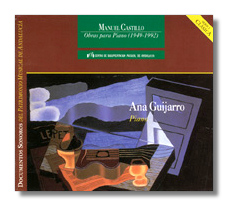
The Internet's Premier Classical Music Source
Related Links
- Castillo Reviews
- Latest Reviews
- More Reviews
-
By Composer
-
Collections
DVD & Blu-ray
Books
Concert Reviews
Articles/Interviews
Software
Audio
Search Amazon
Recommended Links
Site News
 CD Review
CD Review
Manuel Castillo

Piano Works (1949-1992)
- Sonatina (1949)
- Toccata (1952)
- 3 Pieces (1959)
- Preludio, Diferencias y Toccata (1959)
- Intimus (1986)
- Tempus (1980)
- Nocturno en Sanlúcar (1985)
- Sonata (1972)
- Perpetuum (1992)
Ana Guijarro, piano
Almaviva 0119 75min
George Bernard Shaw used to say that in art, it matters more who comes after you than before you. That is, we tend to judge figures by the worth of their successors. C. P. E. Bach, for example, a brilliant composer, has stood in the shade of Haydn and Mozart, who not only developed and enhanced many of his innovations, but also produced more substantial works. Falla's death robbed Spanish music of its most important father figure and, for the most part, the sons – Ernesto Halffter, Carlos Surinach, and Joaquín Rodrigo – while worthy, have yet to live up to their old man. To some extent, Spanish composers have the difficult problem of deciding what to do in the aftermath of the harpsichord concerto, El Retablo de Maese Pedro, and Atlantida.
Manuel Castillo belongs to the Ibérian wing of the Franco-Russian school, except that where someone like Rodrigo takes after Stravinsky, Castillo, particularly in his more ambitious work, seems an Hispanic grand-nephew of Prokofieff. His music seldom refers overtly to Spanish popular tropes and styles, but occasionally something peeks through in a turn of melody or, more often, in a dance rhythm. The music on this disc – as one would expect from composition dates spanning more than forty years – actually runs through a gamut of styles.
The Sonatina (1949) comes off as a charmer in the vein of Milhaud and Poulenc's party pieces, with a sweetly ruminative slow movement. The Toccata sets out unapologetically to knock the listener's socks off with a bit of Falla here, a little Prokofieff there. Early Prokofieff appears in the Three Pieces (1959), with clean piano textures and insistence on a few ideas (they reminded me of the Russian's Sarcasms in this respect). Nevertheless, Castillo's later work emphasizes less the dependence on models and searches more for a personal voice. It's a brave risk, with some pieces coming off better than others. The Sonata (1972) never really gels, partly because it switches textures and ideas too often for its own good, and the large pieces fail to come into focus. Consequently, the emotional momentum of the work dissipates among the smaller fragments. I would say the same of Tempus (1980), an experiment in "psychological," rather than classically formal, progression of musical ideas.
Through this range of style, Guijarro follows the composer with great sympathy. The Sonatina and Toccata come off not only as wit, but, more important, as marvelous fun. She sings beautifully with the Gregorian and serenade themes of Intimus (1986) and manages to bring off delicate bell-like effects as well. A player who clearly likes to show the architectural skeleton beneath the notes, she certainly has the measure of the ambitious Tempus and Sonata. She doesn't just play notes and she doesn't shy from presenting an emotional account. As I say, to me the fault lies in the pieces themselves.
I have far more enthusiasm for the Preludio, Diferencias y Toccata of 1959, for me the finest work on the program. In fact, it shares many of the aspirations of Falla's blazing Fantasia betica – trying to invent a Spanish modernism based on folk sources. Castillo bases the entire 15-minute work on a theme from Albéniz's Ibéria, although perhaps "theme" applies less here than the word "cell" or "motif." In fact, the main generator of the music consists of essentially four notes. Castillo suffers from an excess of modesty here. I certainly wouldn't have connected this work with the Albéniz if Castillo hadn't mentioned it in his notes. Aside from the virtuosity and stamina the piece demands, the pianist must not only master a variety of textures (from "barbaric" chordal pounding to crystalline fugato), but also shape the piece over a long stretch. The minimal thematic material works against this, but Guijarro compels the listener's attention throughout, so that when the fugal toccata arrives, it does so as a surprise and a summation. The composer has expressed his gratitude, as well he should. Guijarro has not only taken his music seriously and mastered it, but has also applied a considerable interpretative imagination. I'm sure she has taught him something about his own music.
The piano sound, while not best-ever, is still clean and acceptable.
Copyright © 1998, Steve Schwartz



















